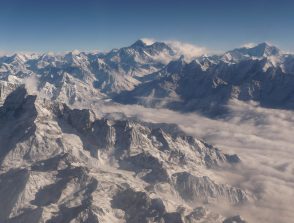Geological sources of electromagnetic anomalies and sulfur emission in the Nepal Himalayas
21/04/2023
IPGP - Îlot Cuvier
14:00
Soutenances de thèses
Amphithéâtre
Sandeep Thapa
Physique des Sites Naturels (PSN)
The objectives of this work are to characterize the geological sources of electromagnetic anomalies reported at crustal depth in the Nepal Himalaya and to improve our understanding of the Himalayan carbon and sulfur cycles. Focusing on the seismogenic Main Central Thrust (MCT) zone, the approach is multidisciplinary, at the frontiers between geology, petrology, geochemistry and geophysics to disentangle the various high electrical conductivity sources. We concentrate our study on the natural laboratory of the Upper Trisuli valley, Central Nepal where sulfide-rich carbon-bearing rocks, carbon- and sulfate-rich hot springs, and gaseous metamorphic carbon dioxide (CO2) emissions marked with hydrogen sulfide (H2S) occur. Based on the study of 144 graphitic phyllites from the MCT zone, we show a metric, kilometric and larger scales coherency of metamorphic conditions. We develop and validate a new SEM-BSE technique to determine the total organic carbon (TOC) content of a rock sample. Graphite is biogenic, flaky to moderately crystalline. First-order extrapolations suggest meta-sediment TOC may represent up to 20% of the total amount of carbon stored in orogens. Central Nepal segment, with higher TOC content and peak metamorphic temperature, is also characterized by the largest current metamorphic CO2 emissions of the chain. The metamorphic CO2 emissions are studied at hydrothermal sites affected by the 2015 Gorkha earthquake and at newly discovered sites. A total of 744 CO2 flux are measured using the accumulation chamber method and dissolved inorganic carbon content of 48 hot springs is determined. The most spectacular findings are the large CO2 release at the Pajung site representing one third of the total metamorphic CO2 emissions in the Nepal Himalaya, and the awakening of the Chilime site about 6 years after the Gorkha earthquake, a rarely observed phenomenon. In addition, exploration campaigns in Eastern and Far-Western Nepal greatly improve our understanding of the along-strike variation and global budget of metamorphic CO2 emissions from the chain. Besides carbon, sulfur sources are also studied at these sites where the three phases occur. A total of 36 hot springs are analyzed for dissolved sulfate and multiple sulfur isotopes over the Nepal Himalaya. In addition to the isotopic signature of graphitic sulfide-bearing phyllites and H2S emissions, 206 H2S fluxes are measured with the accumulation chamber method at Syabru-Bensi, Central Nepal. H2S and CO2 fluxes are correlated, suggesting a crustal contribution of H2S. We find that thermochemical sulfate reduction (TSR) occurs at depth while microbial sulfate reduction (MSR) and mixing dominate at shallow depths. Increases of pyrite oxidation and TSR, followed by pyrite oxidation decrease and MSR increase, may explain the 7-year-long cycle for dissolved sulfate following the Gorkha earthquake. Laboratory measurements of Spectral Induced Polarization (SIP) done on graphitic phyllites from Central Nepal show a strong anisotropy and a substantial frequency dependence of conductivity. Field SIP soundings at graphitic phyllite outcrops and a hydrothermal site show conductive and polarizable zones correlated with graphite and permeable gas conduits, respectively. These new data suggest SIP method can discriminate mobile versus stored carbon at various spatial scales. This thesis opens new perspectives about the relationship between electrical conductivity and carbon, sulfur and geological fluids in seismogenic regions. ----- To attend online (Zoom meeting): https://u-paris.zoom.us/j/82096581029?pwd=VldQZkVyQnIzdnpvZzkzTjY5T3J3dz09 Meeting ID: 820 9658 1029 Password: 012553 -----




